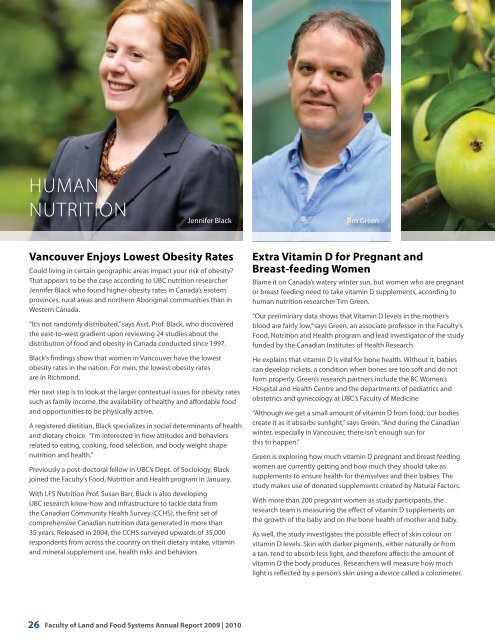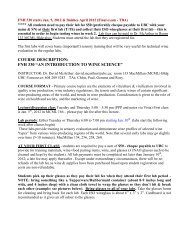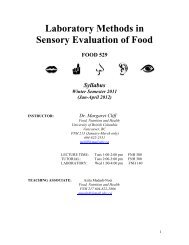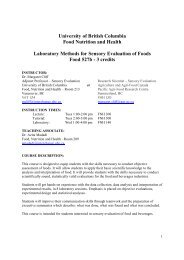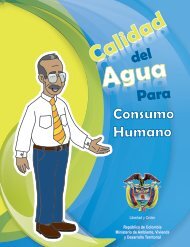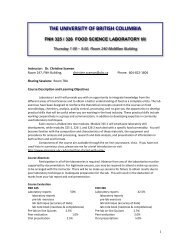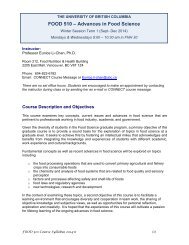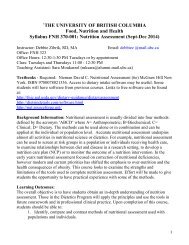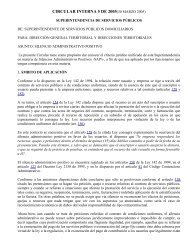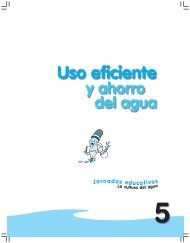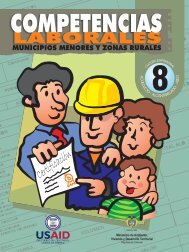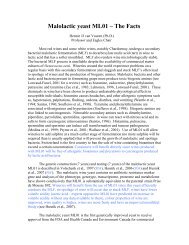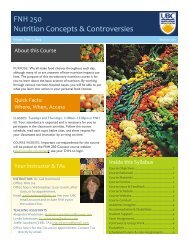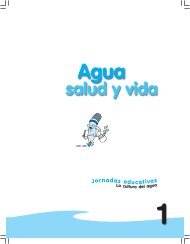download it as a PDF - Faculty of Land and Food Systems ...
download it as a PDF - Faculty of Land and Food Systems ...
download it as a PDF - Faculty of Land and Food Systems ...
- No tags were found...
Create successful ePaper yourself
Turn your PDF publications into a flip-book with our unique Google optimized e-Paper software.
HUMANNUTRITIONJennifer BlackTim GreenVancouver Enjoys Lowest Obes<strong>it</strong>y RatesCould living in certain geographic are<strong>as</strong> impact your risk <strong>of</strong> obes<strong>it</strong>y?That appears to be the c<strong>as</strong>e according to UBC nutr<strong>it</strong>ion researcherJennifer Black who found higher obes<strong>it</strong>y rates in Canada’s e<strong>as</strong>ternprovinces, rural are<strong>as</strong> <strong>and</strong> northern Aboriginal commun<strong>it</strong>ies than inWestern Canada.“It’s not r<strong>and</strong>omly distributed,” says Asst. Pr<strong>of</strong>. Black, who discoveredthe e<strong>as</strong>t-to-west gradient upon reviewing 24 studies about thedistribution <strong>of</strong> food <strong>and</strong> obes<strong>it</strong>y in Canada conducted since 1997.Black’s findings show that women in Vancouver have the lowestobes<strong>it</strong>y rates in the nation. For men, the lowest obes<strong>it</strong>y ratesare in Richmond.Her next step is to look at the larger contextual issues for obes<strong>it</strong>y ratessuch <strong>as</strong> family income, the availabil<strong>it</strong>y <strong>of</strong> healthy <strong>and</strong> affordable food<strong>and</strong> opportun<strong>it</strong>ies to be physically active.A registered diet<strong>it</strong>ian, Black specializes in social determinants <strong>of</strong> health<strong>and</strong> dietary choice. “I’m interested in how att<strong>it</strong>udes <strong>and</strong> behaviorsrelated to eating, cooking, food selection, <strong>and</strong> body weight shapenutr<strong>it</strong>ion <strong>and</strong> health.”Previously a post-doctoral fellow in UBC’s Dept. <strong>of</strong> Sociology, Blackjoined the <strong>Faculty</strong>’s <strong>Food</strong>, Nutr<strong>it</strong>ion <strong>and</strong> Health program in January.W<strong>it</strong>h LFS Nutr<strong>it</strong>ion Pr<strong>of</strong>. Susan Barr, Black is also developingUBC research know-how <strong>and</strong> infr<strong>as</strong>tructure to tackle data fromthe Canadian Commun<strong>it</strong>y Health Survey (CCHS), the first set <strong>of</strong>comprehensive Canadian nutr<strong>it</strong>ion data generated in more than35 years. Rele<strong>as</strong>ed in 2004, the CCHS surveyed upwards <strong>of</strong> 35,000respondents from across the country on their dietary intake, v<strong>it</strong>amin<strong>and</strong> mineral supplement use, health risks <strong>and</strong> behaviors.Extra V<strong>it</strong>amin D for Pregnant <strong>and</strong>Bre<strong>as</strong>t-feeding WomenBlame <strong>it</strong> on Canada’s watery winter sun, but women who are pregnantor bre<strong>as</strong>t feeding need to take v<strong>it</strong>amin D supplements, according tohuman nutr<strong>it</strong>ion researcher Tim Green.“Our preliminary data shows that V<strong>it</strong>amin D levels in the mother’sblood are fairly low,” says Green, an <strong>as</strong>sociate pr<strong>of</strong>essor in the <strong>Faculty</strong>’s<strong>Food</strong>, Nutr<strong>it</strong>ion <strong>and</strong> Health program <strong>and</strong> lead investigator <strong>of</strong> the studyfunded by the Canadian Inst<strong>it</strong>utes <strong>of</strong> Health Research.He explains that v<strong>it</strong>amin D is v<strong>it</strong>al for bone health. W<strong>it</strong>hout <strong>it</strong>, babiescan develop rickets, a cond<strong>it</strong>ion when bones are too s<strong>of</strong>t <strong>and</strong> do notform properly. Green’s research partners include the BC Women’sHosp<strong>it</strong>al <strong>and</strong> Health Centre <strong>and</strong> the departments <strong>of</strong> pediatrics <strong>and</strong>obstetrics <strong>and</strong> gynecology at UBC’s <strong>Faculty</strong> <strong>of</strong> Medicine“Although we get a small amount <strong>of</strong> v<strong>it</strong>amin D from food, our bodiescreate <strong>it</strong> <strong>as</strong> <strong>it</strong> absorbs sunlight,” says Green. “And during the Canadianwinter, especially in Vancouver, there isn’t enough sun forthis to happen.”Green is exploring how much v<strong>it</strong>amin D pregnant <strong>and</strong> bre<strong>as</strong>t feedingwomen are currently getting <strong>and</strong> how much they should take <strong>as</strong>supplements to ensure health for themselves <strong>and</strong> their babies. Thestudy makes use <strong>of</strong> donated supplements created by Natural Factors.W<strong>it</strong>h more than 200 pregnant women <strong>as</strong> study participants, theresearch team is me<strong>as</strong>uring the effect <strong>of</strong> v<strong>it</strong>amin D supplements onthe growth <strong>of</strong> the baby <strong>and</strong> on the bone health <strong>of</strong> mother <strong>and</strong> baby.As well, the study investigates the possible effect <strong>of</strong> skin colour onv<strong>it</strong>amin D levels. Skin w<strong>it</strong>h darker pigments, e<strong>it</strong>her naturally or froma tan, tend to absorb less light, <strong>and</strong> therefore affects the amount <strong>of</strong>v<strong>it</strong>amin D the body produces. Researchers will me<strong>as</strong>ure how muchlight is reflected by a person’s skin using a device called a colorimeter.26 <strong>Faculty</strong> <strong>of</strong> <strong>L<strong>and</strong></strong> <strong>and</strong> <strong>Food</strong> <strong>Systems</strong> Annual Report 2009 | 2010


